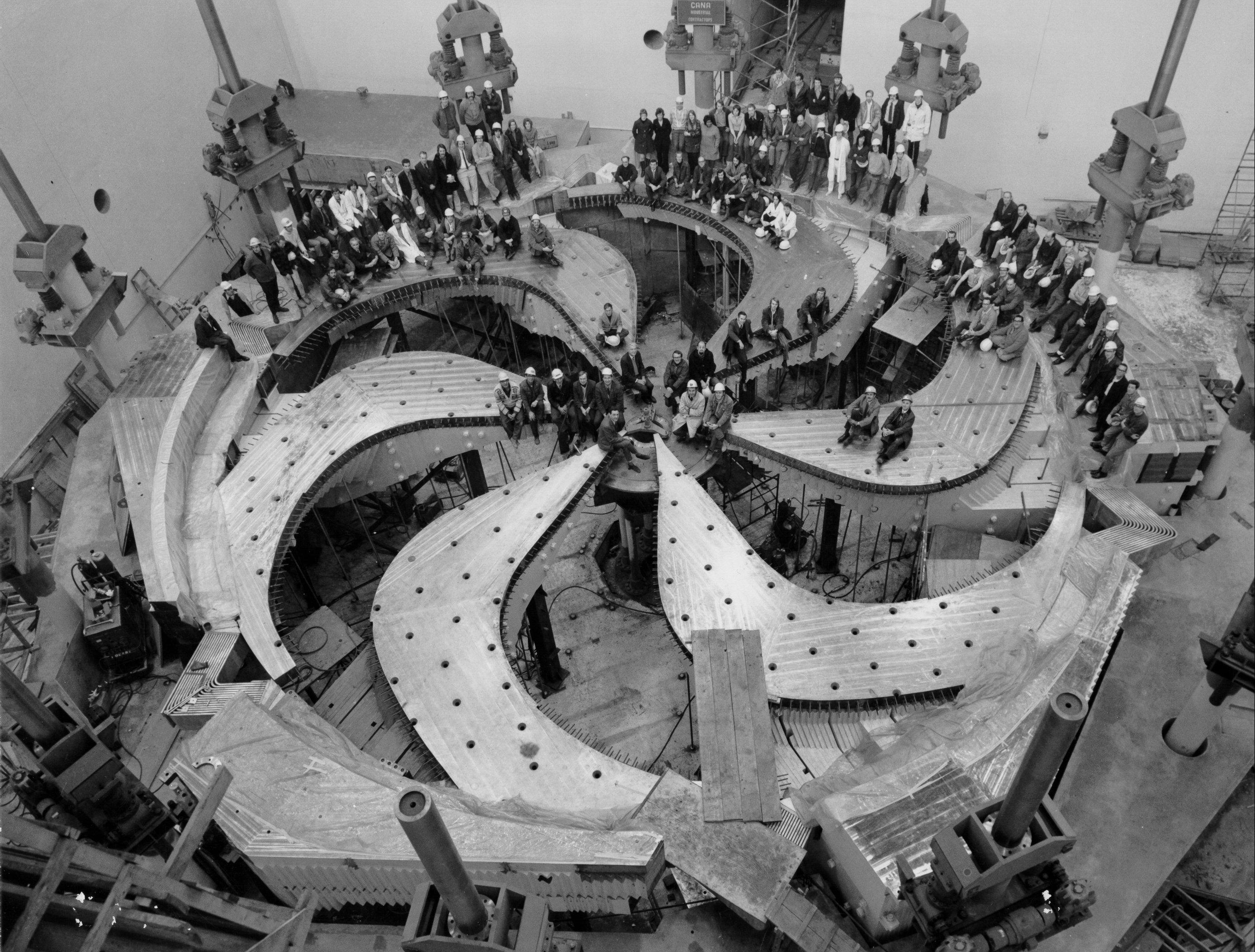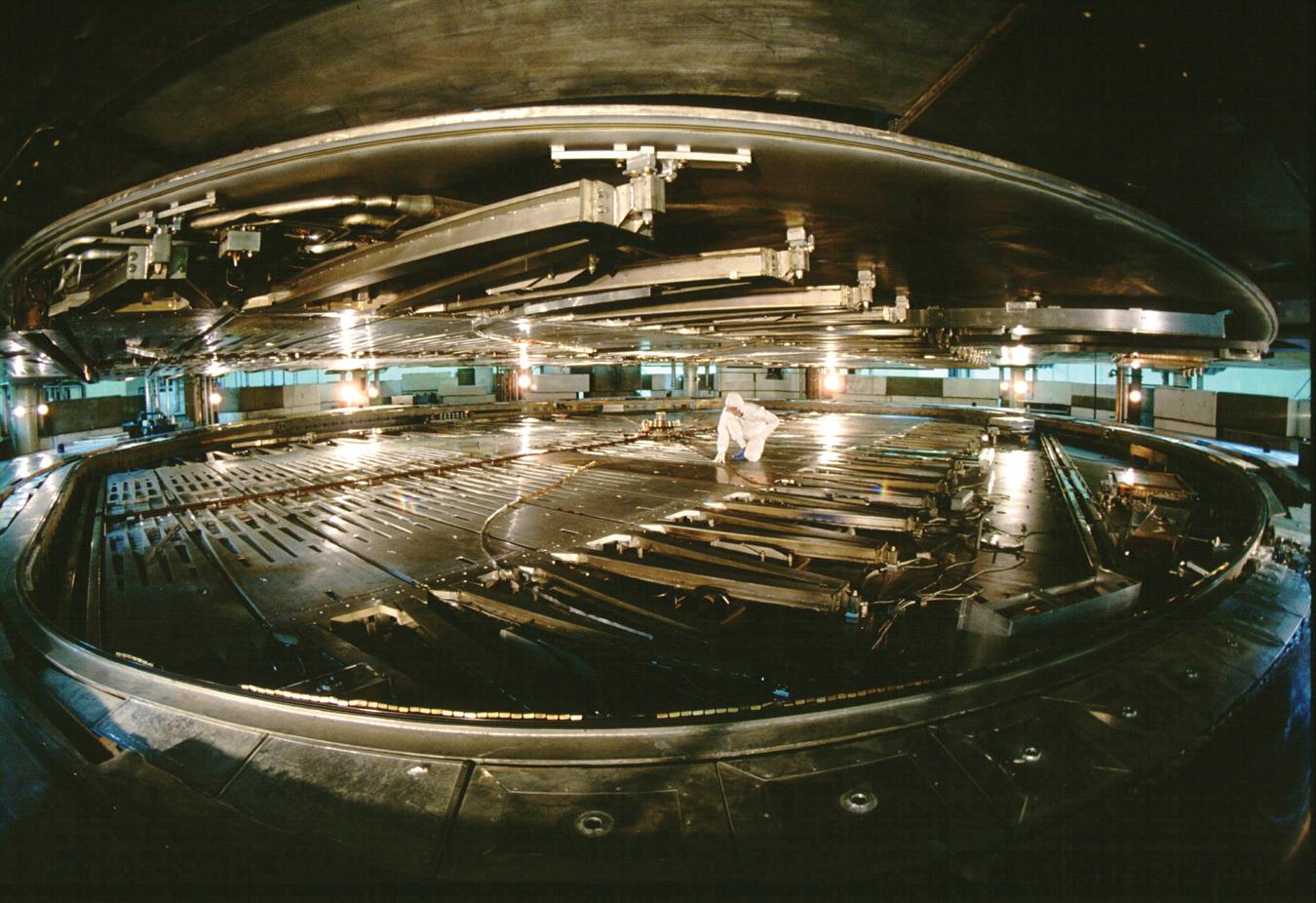First Beams at TRIUMF ... and a 1st for Canada
IEEE has recognized TRIUMF's main cyclotron as an Engineering Milestone. Come celebrate this historic achievement on the 36th anniversary of the first beams extracted from the main cyclotron.
Dedication ceremony at TRIUMF: Thursday, December 16, 2010, 10:00 a.m.
Featuring: E. Blackmore | J. Burgerjon | M. Craddock | R. Eppich and others
|  |
TRIUMF operates five different cyclotrons on site. The largest and most important one is the 500 MeV main cyclotron. the other four cyclotrons are smaller (up to about 40 MeV) and predominantly used for producing medical isotopes.
What is a cyclotron? A cyclotron is a type of accelerator that accleerates charged particles in an "expanding spiral." Each orbit around the centre of the machine, the particles receive a "kick" from an electromagnetic field, adding to their speed. The particles are confined to an orbit by a pair of strong magnets that sandwich the accelerating region; as we learn in high-school physics, charged particles bend in a magnetic field.
Additional Resources
- Description and Images of TRIUMF cyclotron
- History of the pursuit of first beams (by M. Craddock, 1999)
- Video about the main cyclotron
- IEEE Milestone Nomination Materials
- TRIUMF News Release about IEEE Milestone Award
- Technical and engineering facts about the main cyclotron
Overview of the 500 MeV Cyclotron
TRIUMF's main cyclotron produces negatively charged hydrogen ions (H⁻: 1 proton, 2 electrons) from an ion source. The ions are transported through an evacuated electrostatic beam line containing elements to focus and steer the beam over its 60 m to the cyclotron. The 500 MeV (million electron volts) variable energy cyclotron accelerates these ions with a high frequency alternating electric field and uses a massive six-sector magnet to confine the beam in an outward spiral trajectory. Inserting a very thin graphite extraction foil strips, or removes, the electrons from the H⁻ ion while allowing the proton to pass through. The proton, because it is a positively charged particle, is deflected in the outward direction due to the magnetic field and is directed to a proton beam line.
A cyclotron is a special type of particle accelerator that accelerates particles as they follow a spiral path through it. The TRIUMF cyclotron accelerates particles inside an air free chamber between the poles of an electromagnet whose magnetic field guides the particles in an expanding spiral path. The particles are accelerated by 'kicks' of electric voltage every half turn. When the beam reaches the outside edge of the tank, it is bent into pipes called beam lines, which lead to experimental halls.
Facts about the TRIUMF main cyclotron:
- Total magnet weight: 4,000 Tons
- Magnet diameter: 18 m (59ft)
- Magnetic field: Up to 5,600 gauss (the Earth's magnetic field is about 0.5 gauss)
- Current required by the magnets: 18,500 Amps
- Electric field frequency: 23 million cycles per second (23 MHz)
- Time required for acceleration: 326 microseconds (1/3000th of a second)
- Particle speed at maximum energy: 224,000 km/sec - 3/4th the speed of light. At this speed you could travel from the earth to the moon in two seconds.
- Particles accelerated per second: 1,000 trillion. TRIUMF has one of the most intense proton beams in the world.
The cyclotron produces beams of protons. By making these protons strike different kinds of targets, intense beams of neutrons, pions and muons (other elementary particles) can also be created, thus making possible many different kinds of experiments.
The accelerating process takes approximately 0.3 ms before the proton achieves three-quarters the speed of light. The success of TRIUMF’s programs depends on the ability to deliver protons from the cyclotron reliably. Typically, the cyclotron, although over 30 years old, averages an uptime of greater than 90% (2000–2007), with the 15-year average just under 90%. Typically the beam is delivered for about 5,000 hours per year with one major (three month) and one minor (one month) maintenance periods. The cyclotron beam properties and capabilities have improved over the years as a result of systems upgrades.
Selected Key Accomplishments
The TRIUMF cyclotron is not only unique in its size, but also because of its ability to reliably deliver multiple beams of protons at different energies and intensity simulatenously. This flexible and robust design has enabled key scientific discoveries and applications for the past 36 years.
For instance:
Because of its high intensity and the time structure of its beam, the cyclotron powered the world-leading PIENU experiment. PIENU measured branching ratios of pion decays which improve an earlier sets of experiments from a 0.1% precision level (1986) to 0.03% in (1992) and in the present run will likely reach < 0.01%. This measurement provides a crucial test of the identical nature of muons and electrons (apart from their masses).
Because of its energy variability and polarized beam capacilities, the cyclotron was used in parity experiments. The parity experiments look atr weak-interaction effects in proton-proton scattering. Tour de force experiments were performed at TRIUMF which relied on a unique high intensity polarized beam at several energies. These experiments provides the best constraints on some of the meson coupling constants describing these weak effects in hadronic physics.
Because of its capacity for concurrent multiple beam extractions at high intensitites, the cyclotron drives an isotope production program for physics, muon produtionc for materials science, medical-isotope production for commercial sale and distribution, and proton/neutron irradiation for aerospace device testing.
- The ISAC experimental program with its mass measurement of very neutron rich short lived nuclei: as one example, TRIUMF is producing the world's best 11Li beams and the mass, radius of the 11Li nucleus, an isotope of lithium living only for less than 10 msec, was determined with the TITAN facility. Orders of magnitude improved mass determinations are now possible which have a direct impact on nuclear astrophysics reaction networks trying to explain the origin of all the elements.
- Likewise, the cyclotron simultaneously drives a world-leading materials-science program using polarized muons as a sensitive probe of magnetic properties of new materials in particular warm superconductors which are becoming essential in many new technologies: transport of electric currents, information technologies etc.
- Also at the same time with a third dedicated extracted beam, the cyclotron is used to produce 82Rb, a medical isotope used in (radio-)tracers extensively for cardiac PET imaging and which is distributed by Nordion for imaging cameras all over the world. TRIUMF/Nordion are one of the best suppliers of this isotope.
- The cyclotron also produces high intensity and dispersed floods of protons and/or neutrons for irradiation testing of materials and devices.
| Attachment | Size |
|---|---|
| 44.36 KB | |
| 4.75 MB |

